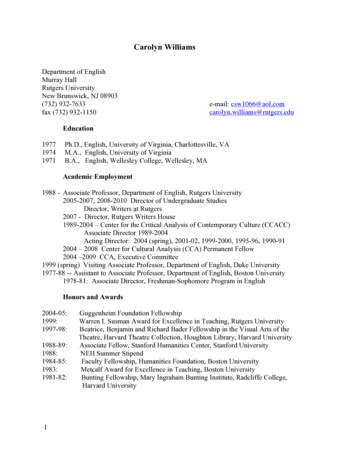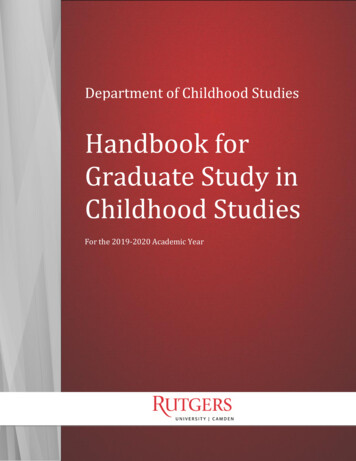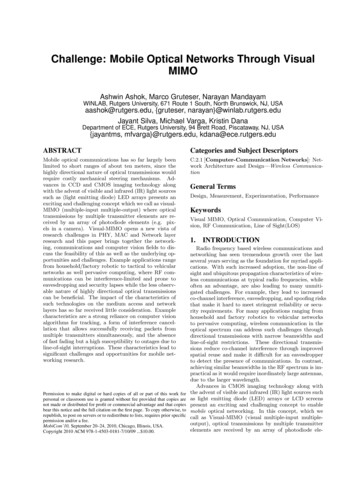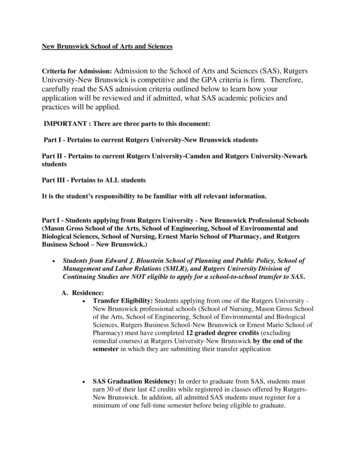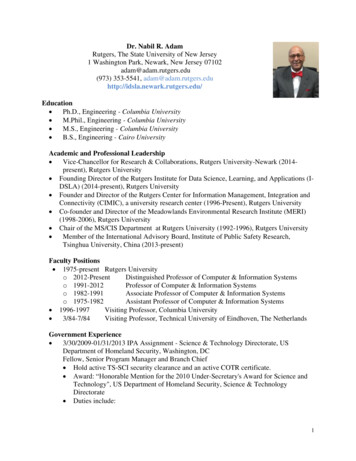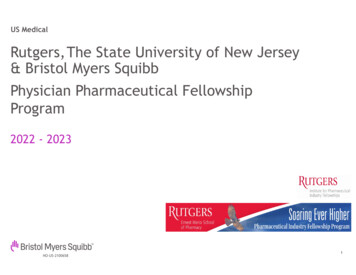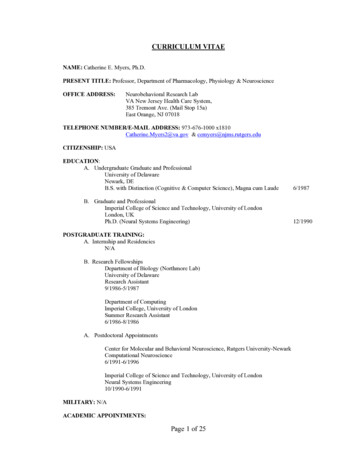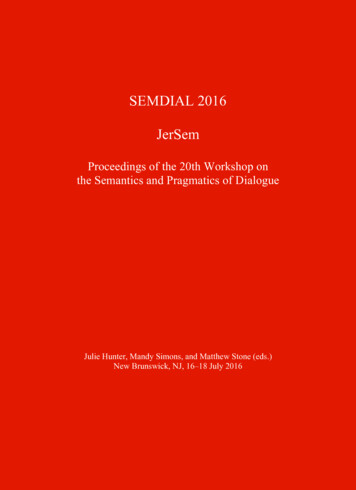
Transcription
SEMDIAL 2016JerSemProceedings of the 20th Workshop onthe Semantics and Pragmatics of DialogueJulie Hunter, Mandy Simons, and Matthew Stone (eds.)New Brunswick, NJ, 16–18 July 2016
ISSN 2308-2275Serial title: Proceedings (SemDial)SemDial Workshop Serieshttp://www.illc.uva.nl/semdial/JerSem Websitehttp://semantics.rutgers.edu/jersem/i
PrefaceJerSem marks the twentieth year of the annual SemDial Workshop on the Semantics andPragmatics of Dialogue! We are delighted to hold the meeting in New Brunswick, NewJersey, and to follow up 2011’s Los Angelogue by bringing the SemDial meeting to NorthAmerica for only the second time. This year, we have collocated SemDial with the NorthAmerican Summer School in Logic, Language and Information(http://nasslli2016.rutgers.edu/). Both events are known for bringing together disciplinesfrom across cognitive science and we hope the opportunity for extended participation in bothevents strengthens this cross-fertilization. To capitalize on overlaps with NASSLLI onquestions under discussion and the problems of dialogue, we organized the first day ofSemDial as a special session on “Questions under Discussion”, to focus on the role ofdiscourse purposes in utterance interpretation and dialogue structure, and their reflection inutterance form.We received a total of twenty full paper submissions. Ten of those papers will be presented atJerSem, after selection based on a round of anonymous peer review that secured writtenevaluations from three experts on each submission. We are extremely grateful to the ProgramCommittee members for their very detailed and helpful reviews. The poster session hostsseven additional contributions that came in response to a call for late-breaking posters anddemonstrations. All accepted full papers and poster abstracts are included in this volume. Weare pleased that the mix of papers continues to reflect the diverse range of methods availableto dialogue research, including experimental studies, corpus studies, and formal andcomputational models.The JerSem program features four keynote presentations, by Jonathan Ginzburg, Kordula deKuthy, Nigel Ward and Elisabeth Camp (in order of appearance). We thank them forparticipating in SemDial and are honored to have them at the workshop. Abstracts of theircontributions are also included in this volume.JerSem has received generous financial support from the Rutgers Center for CognitiveScience (http://ruccs.rutgers.edu). Partial funding for the Special Session “Questions UnderDiscussion” has been provided by NSF support of project number 1452674 “What's thequestion? A cross-linguistic investigation into compositional and pragmatic constraints on thequestion under discussion.” We are very grateful for this sponsorship. We have also beengiven the endorsement of SIGdial, the special interest group on discourse and dialogue of theAssociation for Computational Linguistics and the International Speech CommunicationAssociation.Last but not least we would like to thank everyone else who helped with Page i of 5theorganisation, particularly acting RuCCS directors Ernie Lepore and Gretchen Chapman,RuCCs staff members Sue Cosentino and Jo’Ann Meli, and our student helpers.Julie Hunter, Mandy Simons and Matthew StoneNew Brunswick, NJJuly 2016i
Program CommitteeJulie Hunter (co-chair), University of Toulouse III - Paul SabatierMandy Simons (co-chair for special session on QUD), Carnegie Mellon UniversityMatthew Stone (co-chair), Rutgers UniversityNicholas Asher, Université Paul SabatierDavid Beaver, University of TexasClaire Beyssade, Université de Paris 8Ellen Breitholtz, University of GothenburgEve Clark, Stanford UniversityJudith Degen, Stanford UniversityValeria de Paiva, NuancePaul Dekker, University of AmsterdamDavid DeVault, University of Southern CaliforniaSimon Dobnik, University of GothenburgRaquel Fernandez, University of AmsterdamKallirroi Georgila, University of Southern CaliforniaJonathan Ginzburg, Université Paris-DiderotEleni Gregoromichelaki, King's College LondonPat Healey, Queen Mary University LondonJulian Hough, University of BielefeldChris Howes, University of GothenburgAmy Isard, University of EdinburghAndrew Kehler, University of California San DiegoRuth Kempson, King's College LondonStaffan Larsson, University of GothenburgAlex Lascarides, University of EdinburghOliver Lemon, Heriot-Watt UniversityPierre Lison, University of OsloMarie-Catherine de Marneffe, The Ohio State UniversityGregory Mills, University of GroningenChris Potts, Stanford UniversityMatthew Purver, Queen Mary University LondonKyle Rawlins, Johns Hopkins UniversityHannes Reiser, University of BielefeldCraige Roberts, The Ohio State UniversityDavid Schlangen, University of BielefeldAmanda Stent, Yahoo!Judith Tonhauser, The Ohio State UniversityDavid Traum, University of Southern Californiaii
ContentsInvited SpeakersQUD: Past, Present, and FutureJonathan Ginzburg.1Annotating Questions under Discussions in Authentic DataKordula De Kuthy .2Prosody, Action, and Coordination in Real-time GameplayNigel G. Ward .3Sarcasm in Conversational ActionElisabeth Camp .4Full PapersWhy?Julian J. Schlöder, Ellen Breitholtz, and Raquel Fernández .5Joint Information Structure and Discourse Structure Analysis in an Underspecified DRTFrameworkUwe Reyle and Arndt Riester .15A Model for Attention-Driven Judgements in Type Theory with RecordsSimon Dobnik and John D. Kelleher .25Grounding, Justification, Adaptation: Towards Machines That Mean What They SayDavid Schlangen .35Comparing Dialogue Strategies for Learning Grounded Language from Human TutorsYanchao Yu, Oliver Lemon, and Arash Eshghi.44Evaluating Conversational Success: Weighted Message Exchange GamesNicholas Asher and Soumya Paul .55Disagreement with Evidentials: A Call for SubjectivityNatalia Korotkova.65Prominence Shifts in English and Spanish Parallel ConstructionsJeffrey Klassen, Michael Wagner, Annie Tremblay, and Heather Goad.76Impotent Speech Acts and AwarenessPhil Crone .86Multi-layered analysis of laughterChiara Mazzocconi, Ye Tian, and Jonathan Ginzburg .97iii
Short PapersExtralinguistic State Localization in Service of Turn Generation in Task-Oriented DialoguePetr Babkin .108Structural focus and discourse structure in Hungarian narrativesKata Balogh .110Are you mocking me or are you laughing with me?Ellen Breitholtz and Kristina Lundholm Fors .112PentoRob: A Puzzle-Playing Robot for Dialogue ExperimentsJulian Hough and David Schlangen .114Generating Surplus Content in a Q/A-SettingSebastian Reuße, Ralf Klabunde, Jon Stevens, and Anton Benz .116Aligning Intentions: Acceptance and Rejection in DialogueJulian J. Schlöder, Antoine Venant, and Nicholas Asher .118An Incremental Dialogue System for Learning Visually Grounded Language(demonstration system)Yanchao Yu, Arash Eshghi, and Oliver Lemon.120iv
QUD: Past, Present, and FutureJonathan GinzburgCLILLAC-ARP (EA 3967) & Laboratoire d’Excellence (LabEx)—EFLUniversité Paris-Diderot, Paris, Franceyonatan.ginzburg@univ-paris-diderot.frIn this talk I will start by considering some past motivations for positing QUD, arepository of questions that conversational participants exploit in, arguably, just aboutany form of interaction. A number of distinct QUD theories are possible, withparameters including how shared its elements are and the nature of its ordering. I willshow how QUD enables a theory of interaction to accommodate and sharpen insightsconcerning domain dependence (from AI) and other-repair (from conversationalanalysis), and indeed to significantly change our view of grammar by integrating selfrepair. I will conclude by discussing how appraisal theories utilised in cognitivetheories of emotion can be integrated in interaction theories, along with morespeculative comments on gesture and music.1
Annotating Questions under Discussions inAuthentic DataKordula De KuthyUniversity of Tübingenkdk@sfs.uni-tuebingen.deThe information structure of sentences is receiving increased interest in linguisticsas the attention has shifted from the analysis of isolated sentences to the question howinformation is packaged in sentences analyzed in context. In order to connect theinformation structure of sentences to the overall structure of the discourse, an analysisin terms of Questions under Discussion is proving to be a useful tool.According to Roberts’ (2012) account, natural discourse in general serves to answerhierarchically ordered Questions under Discussion (QUDs). These implicit QUDs canbe used to account for the information structure of utterances in context: the part of asentence contained in the formulation of the current question is called the background,while the part which provides the actual answer is the focus.The notion of implicit QUDs has also been referenced in corpus-based researchattempting to analyze the information structure of naturally occurring, authentic data(e.g., Ritz et al., 2008; Calhoun et al., 2010). Yet these approaches were only rewardedwith limited success in terms of achieving agreemen, arguably because the task ofidentifying QUDs was not made explicit.In this talk reporting joint work with Arndt Riester, we introduce our methodologyfor a combined analysis of data in terms of both discourse and information structure,integrating an explicitly spelled out notion of QUDs. We identify the necessary stepsof an analysis procedure based on QUDs and demonstrate the method on authentic datataken from a German spoken-language corpus. We formulate pragmatic principles thatallow us to analyze the discourse structure, formulate adequate QUDs, and analyze theinformation structure of individual utterances in the discourse. Based on the authenicdata analysis, we illustrate that the formulation of QUDs can be successfully guided bythe formulated principle and that QUDs play a crucial role in accounting for discoursestructural configurations. At the same time, they also provide an objective means todetermine the information structure, including both the focus-background divide aswell as not-at-issue content.ReferencesCalhoun, S., J. Carletta, J. Brenier, N. Mayo, D. Jurafsky, M. Steedman, and D. Beaver(2010). The NXT-format switchboard corpus: A rich resource for investigating thesyntax, semantics, pragmatics and prosody of dialogue. Language Resources andEvaluation 44, 387–419.Ritz, J., S. Dipper, and M. Götze (2008). Annotation of information structure: An evaluation across different types of texts. In Proceedings of the 6th International Conference on Language Resources and Evaluation, Marrakech, Morocco, pp. 2137–2142.Roberts, C. (2012). Information structure in discourse: Towards an integrated formaltheory of pragmatics. Semantics and Pragmatics 5(6), 1–69.2
Prosody, Action, and Coordination in Real-time GameplayNigel G. WardDepartment of Computer ScienceUniversity of Texas El Pasonigel@utep.eduLanguage is invaluable for real-time coordination of action. We are studying this in acorpus of fast-paced games in which pairs of players cooperate to solve a maze withobstacles and puzzles. The players routinely perform astounding feats ofcommunication, rapidly producing utterances which simultaneously convey multipledimensions of semantic and pragmatic information, and which are adaptedcontinuously as the game state and dialog state change. To investigate, we appliedunsupervised methods to discover the most common patterns, considering bothprosodic features and game-action features. We found superimposable behaviorpatterns that involve both language acts and domain actions, and that are comprised ofsynchronized contributions by both players. These phenomena and patterns posechallenges for many current theories, models, and technologies.3
Sarcasm in Conversational ActionElisabeth CampDepartment of PhilosophyRutgers, the State University of New Jerseyelisabeth.camp@rutgers.eduSarcasm is a paradigmatically pragmatic phenomenon: the most obvious case ofmeaning something other than what you say. It is also a pragmatically important andpuzzlingly complex phenomenon. It is a key tool for joking, nudging and shamingone another into conversational alignment, but it often seems to underwrite a kind ofcommunicative bluff: it enables speakers to make a conversational move withoutshouldering commensurate conversational liability. Further, its communicativeeffects range from stiletto-sharp clarity (‘You sure know a lot.’) to infuriatinglyamorphous evocation (‘How old did you say you were?’). I argue that we can analyzea wide range of sarcastic utterances in traditional terms of ‘meaning inversion’ if wetake a broader view of meaning than philosophers and linguists have traditionallydone. Different species of sarcasm take different aspects of meaning as targets forinversion, producing systematically distinct conversational effects.4
Why?Julian J. Schlöder: , Ellen Breitholtz; and Raquel Fernández::Institute for Logic, Language and ComputationUniversity of Amsterdam;Department of Philosophy, Linguistics and Theory of ScienceGothenburg Universityjulian.schloeder@gmail.com, ellen@ling.gu.se, raquel.fernandez@uva.nlAbstractEven casual dialogue contains instances ofreasoning. A paradigmatic case is the usage of Why-questions that intuitively elicita reason for something. We present athorough analysis of Why-questions in dialogue from a rhetorical perspective. Wespecify the semantics of Why-questions,i.e., we define what the space of acceptable answers is, how this acceptabilityis itself up for further negotiation, anddiscuss some context-sensitive aspects ofbare Why?. We formalise our model in atype-theoretical framework.1IntroductionParticipating in a dialogue requires the interlocutors to reason about certain propositions and circumstances. On one hand, interlocutors are generally expected to back up the assertions they makewith arguments, should this be required. On theother hand, the notion of relevance of an utteranceis linked to reasoning: a relevant utterance is madefor a reason, e.g., to provide or inquire about information pertinent to the purpose of the dialogue.Such reasons are not always explicated by theinterlocutors, but can be elicited by clarification questions (Jackson and Jacobs, 1980; Breitholtz, 2010; Schlöder and Fernández, 2015). Theparadigmatic examples are Why-questions. We areinterested in what constitutes the space of possible answers to such questions and how they are interpreted in a discourse. The following examplesretrieved from the British National Corpus (BNC)(Burnard, 2000) exemplify the basic phenomenon.(1) a. B: He’s in hospital.b. C: Why?c. B: Because he’s not very well(BNC, file KBF, lines 3394–3396)(2) a. G: Do you want mum to come to Argoswith me tomorrow morning?(three lines omitted)b. R: Why are you asking me?c. G: Cos you said you’d come to Argos withme.(BNC, file KC8, lines 191–196)In (1), B makes an assertion and C asks for areason that backs the truth of the proposition expressed in (1a); note that this need not entail that Cis doubting the content of B’s assertion. We contrast this with what is happening in (2). There,G asks a question and R inquires about G’s reason for doing so. In both cases, the initial speakerthen supplies a reason that is marked with the particle ‘because’. Here, we use the concept ‘reason’intuitively—only if we can define what makes areason, we can define what makes an answer to aWhy-question.A first observation is that the arguments expressed by the first and third utterances in (1) and(2) are logically incomplete: they indicate that thethird utterance is a reason for the first, but not whatwarrants the inference. In classical rhetoric, sucharguments are called enthymemes. An enthymemeis an argument of the form ‘p hence q’ which requires the listener to supply one or more underpinning premises. It has been observed that enthymematic reasoning is widespread in natural dialogue, and has been linked to clarification andcognitive load management (Jackson and Jacobs,1980; Breitholtz and Villing, 2008). Therefore, wewill analyse different types of Why-questions interms of enthymematic reasoning to find out whatthe correlation is between rhetorical structure anddifferent types of Why-questions.The paper is structured as follows: In the nextsection, we will give an overview of existing workin discourse modelling related to reasoning, Whyquestions and enthymemes. Afterwards, in section 3 we will further elucidate the dynamics ofenthymematic reasoning with natural dialogue ex-Appears in JerSem: The 20th Workshop on the Semantics and Pragmatics of Dialogue,edited by Julie Hunter, Mandy Simons and Matthew Stone. New Brunswick, NJ USA,July 16-18, 2016, pages 5-14.
amples. We will describe a formal treatment of ouranalysis in section 4.2These phenomena have also been discussedfrom the perspective of discourse relations; mostnotably in the SDRT framework (Asher and Lascarides, 2003). SDRT includes the discourse relations Explanationpα, βq and Resultpβ, αq. Theserelations are assigned to α and β only if it is true inthe underlying world model that β can be a causefor α. Because these inferences are done in a defeasible logic, SDRT can also account for the factthat sometimes β does not explain α in spite of ‘β,hence α’ being a valid form of inference.SDRT also includes meta-discursive versionsof these relations. These model the fact thatsometimes speakers give reasons for making certain speech acts, as e.g., in example (3) wherethe speaker gives a reason for making a suggestion. A relation particularly interesting to us isQ-Elabpα, βq that applies when β asks a questionpertinent to the goal that the speaker of α wants toachieve by uttering α. To our understanding, Whyquestions broadly fall under this umbrella, but nosuch account of Why? has yet been elaborated.We prefer the rhetorical approach over the discourse relations model for the following reason.As our analysis will show, inference patterns aredynamic in that they can be presupposed, accommodated, elicited and themselves be discussed.The SDRT account, as far as we understand it, isnot amenable to such flexibility. In particular, thesemantics of Q-Elabpα, βq requires that the spaceof possible answers to β is fixed and known (Asherand Lascarides, 2003, Sec. 9.3.3). If β is a Whyquestion, we do not believe this to be the case.This is because the answer set to a Why-questiondepends on the available topoi. Since topoi are dynamic, so must be these answer sets.An important consequence of this, as we see it,is that the acceptability of a given reason does notdepend on an inferential relationship being correct(in some objective sense, e.g., in a model), butmerely on it being subjectively acceptable to theinterlocutors. Acceptability, in turn, depends onthe rhetorical resources of individual speakers.2Reasoning in DialogueMany conversational phenomena like disagreement, misunderstanding, and clarification canbe linked to enthymematic reasoning (Breitholtz,2014a). Consider the example in (3).(3) A: Let’s walk along Walnut StreetIt’s shorter(cited from Walker (1996))This excerpt is uttered in the context of two colleagues on their way to work, where several routesare possible. Speaker A suggests to take one ofthem and provides a reason supporting this. Thetwo propositions convey an enthymeme: an argument that relies on generally recognised facts andnotions regarding how it is acceptable to reason.Enthymemes consist of two parts, a premise and aconclusion, as in the case of our example:1(4)It (Walnut Street) is shorter6 Let’s walk along Walnut StreetIn this case the speaker counts on the interlocutorbeing able to supply something that underpins (3).That is, something that warrants its interpretationas an argument while simultaneously validating it.These kinds of underpinnings are often referredto as topoi in the literature on rhetoric and argumentation. Some topoi may be applied to various subjects, while others are specific to a particular subject. Ducrot (1980; 1988) and Anscombre(1995) talk about topoi as links between propositions that are necessary for the propositions to cohere in discourse. A topos that could be drawnupon to validate the argument in (3) could besomething like ‘if a route is shorter (than otheroptions), choose that route’.We refer to the topoi that are available to an individual as that individual’s rhetorical resources.On this view, speakers have access to a vast set oftopoi which to a great extent mirrors the experiences they have had. Another important aspect ofthis view is that the topoi accessible to one individual do not constitute a monolithic logical system.In contrast to, for example, a representation ofworld knowledge, a set of topoi may contain contradictions or principles of inference which lead tocontradictions.3Analysing ReasonsWe now describe how we model what counts as areason, i.e., what counts as an answer to a Why2This also means that our interest in Why-questions differsfrom analyses that seek to elucidate what explanations arein philosophy of science (Bromberger, 1992; van Fraassen,1980). Our reasons are dialogical phenomena, whereas theirexplanations are, roughly, about natural or physical laws.1This distinguishes them from logical arguments or syllogisms which typically have three parts: A premise, a conclusion, and a rule sanctioning the inference.6
question. We then discuss by way of exampleshow these questions are used and answered in dialogue and how they contribute to grounding. Then,we summarise our findings and present some interesting cases that fall outside our analysis.3.1mentions the principle that he takes to back theconditional statement in (7a).3(7) a. D: I’m self-funding my campaign, I tell thetruth.b. J: ‘I’m rich, therefore I tell the truth’ has[. . .] no cause and effect between the two.Reasons(from Last Week Tonight, Feb. 29th, 2016)Certainly, the answers given by B and G in ourinitial examples (1) and (2) are not arbitrary. Notany utterance would be an acceptable answer tothe Why-questions in these examples. Similarly,not every utterance that expresses ‘p because q’ isimmediately acceptable to its addressee. We stipulate that q is a reason for p if there is a topos thatvalidates the enthymeme q 6 p. Stating that ‘pbecause q’, ‘if q, then p’ or answering ‘q’ to ‘Whyp?’ expresses that q is a reason for p. Hence, suchutterances presuppose that there is such a topos.Thus, addressees can either retrieve an appropriate topos from their set of rhetorical resources orinfer and accommodate a new one.The following examples provide evidence forthis conception.The explication of the topos in (7b) suggests to usthat J has interpreted D’s utterance as (8).4(8)3.2Contextual dependence of Why-questionsBased on this definition of what makes a reason,we now look into the context of Why-questions.We propose that the reasons elicited by these questions are dependent on (i) the current issue under discussion and (ii) the form of the question itself, i.e., its sentential or non-sentential character.The elicited reasons can be either factive (‘whyp?’, given some proposition p under discussion) ormeta-discursive (‘why are you saying p / asking q /suggesting r?’, given some salient dialogue act).5While any type of reason can be queried with asentential Why-question, only a restricted set ofpossible reasons can be elicited by bare Why?.(5) a. J: I roasted it and we couldn’t eat it on theSunday andb. A: Could not? Why could you not eat it?c. J: That was bull beef.d. A: Oh right.e. H: our second class beef, you see.f. J: Then I, I put it in a saucepan and Istewed it the next day3.2.1Factive reasonsIn contexts where the current issue under discussion has arisen from an asserted proposition, Whyquestions typically ask for a reason justifying theasserted content. For instance, example (5b) is asentential form of such a factive Why-question andexample (1b) from the Introduction is a bare factive Why?. We consider the following to be an appropriate reading of (1a,c).(BNC, file K65, lines 284–299; some backchannelutterances omitted)In (5c), J gives an answer to a Why-question, i.e.,J gives what she construes to be a reason for ‘being unable to eat the roast’. Speaker A indicatesthat he accepts this as an answer, but H still elaborates in (5e). The addtional information in (5e,f)suggests the following enthymeme:(6)D self-funds his campaign6 D tells the truthTopos: rich people tell the truth3This example is from the TV show Last Week Tonight.(7a) is an excerpt from a speech by Donald Trump; (7b) isJohn Oliver’s commentary.4Though (8) is not the only possible interpretation of (7a).5We call Why-questions ‘factive’ if they inquire about aclaim and contrast them with those inquiring about an act.We do not claim that such questions are factive in the sense offactive verbs like know. One can pose a factive Why-questionwithout presupposing the truth of the claim, e.g., ‘Why wouldthis be true?’. Some prior work, e.g., Hempel (1965) or Hintikka and Halonen (1995), claims that a Why-question carries its core proposition as a presupposition (sometimes, e.g.,Bromberger (1992), with the restriction that the content is inindicative mood, excluding ‘Why would.’ cases). The observations we make seem to cast doubt on this. Apparently,one can ask ‘Why p?’ without accepting p. An example is(25) below; see our discussion there.x is bull beef6 J could not eat roasted xTopos: one cannot roast bull beef(but ought to stew it)This dialogue offers evidence for our claim thatwhat makes (5c) an answer to (5b) is the more general statement indicated in (5e,f), i.e., the topos of(6). To an interlocutor that is unaware of this information, answering (5c) to (5b) would seem likea non sequitur. The following example is an explicit case in point. The second speaker explicitly7
(9)x is not very well6 x is in the hospitalTopos: unwell people go to the hospitaland (13) is that the topos implicit in (12) is explicated in (13)—but the explication again presupposes a new implicit inference pattern.Similarly, in the next example, the asker of theWhy-question is not able to accommodate the answer as a reason. So he questions the relevance ofthe answer with So what? (we will further discussSo what? in the next subsection).An interesting special case arises when the issueunder discussion stems from a conditional statement. Then, Why? elicits a backing for an alreadystated premise–conclusion pair (i.e., it elicits a reason for the enthymeme itself ). Simply put, askingfor the grounds of a conditional statement elicitsan underpinning premise, but the application ofthis premise is itself enthymematic.(14) a. P: I was with Nanna and Adrian.b. R: No Daddy said you should be withMichelle and Mutty.c. P: xunclearyxpausey Why do I xunclearyNan and Adrian?d. R: Well cos xpausey erm some of the questions are sort of, English questions.e. P: So what?f. R: Well Michelle’s not English.(10) a. D: If you feel cold you’d be dead.b. C: Why?c. D: You just are. Part of you being alive isthat you’re warm.(BNC, file KBW, lines 11065–11068)(BNC, file,KD0, lines 3624–3629)The utterance (10a) states an inferential relationship without giving grounds for the relationship.The Why? in (10b) asks for a reason for this relationship, i.e., for the premise in (11).(11)The dialogue (14) is about assigning groups insome (not further specified) game. In (14e),speaker P indicates that he does not see whatmakes (14d) an answer to (14c). Then, in (14f),R supplies an additional premise that supports thefollowing nested enthymeme.–6 (x is cold 6 x is dead)Put differently, (10b) asks for a reason why x iscold is a reason for x is dead. Thus, we representthe content of (10a) as the enthymeme in (12) and(10b) as asking about the topos of (12).(12)(15)x is cold6 x is deadTopos: –Michelle is not Englishthere are some English questions66 P should be with Michelle and MuttyTopos: Non-English people need help withEnglish questionsThen, the utterance (10c) supplies such a topos, sothe nested enthymeme in (13) is a representationof what is under discussion after (10c).The enthymeme in (15) particularly exemplifiesthe notion described above: Once elicited, a backing becomes a premise in a superordinate enthymeme that again requires an implicit topos tobe interpreted.(13)3
Program Committee Julie Hunter (co-chair), University of Toulouse III - Paul Sabatier Mandy Simons (co-chair for special session on QUD), Carnegie Mellon University Matthew Stone (co-chair), Rutgers University Nicholas Asher, Université Paul Sabatier David Beaver, University of Texas Claire Beyssade, Université de Paris 8
